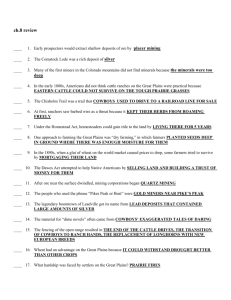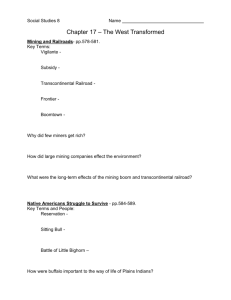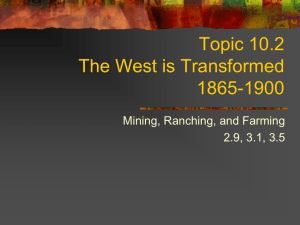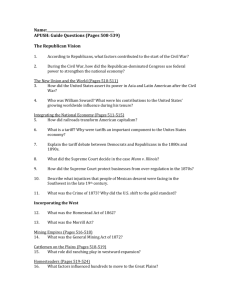B. - White Plains Public Schools
advertisement
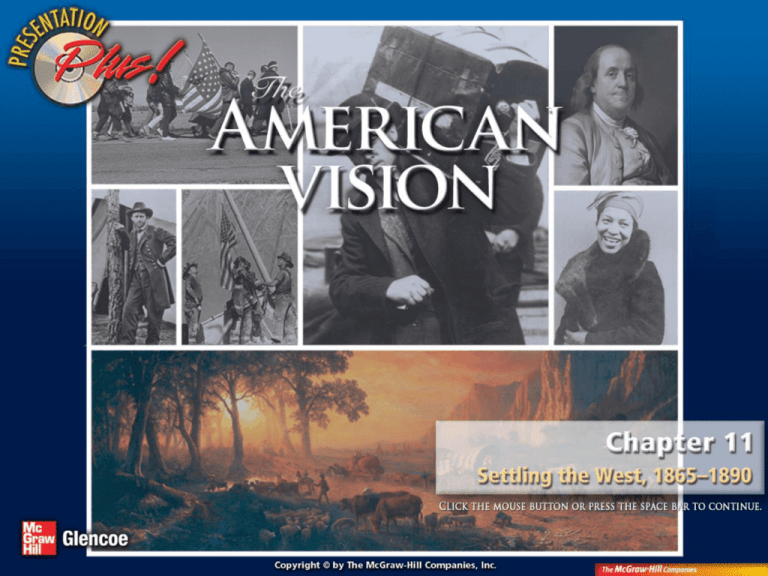
Chapter Introduction Section 1: Miners and Ranchers Section 2: Farming the Plains Section 3: Native Americans Visual Summary Why Did Settlers Move West? After the Civil War, many American settlers continued migrating to the western frontier. The lives of western miners, farmers, and ranchers were filled with hardships. • Why do you think settlers continued migrating west when life on the Great Plains was so difficult? • When the frontier closed what effect do you think this had on American society? Miners and Ranchers What economic opportunities did miners and ranchers seek? Farming the Plains What difficulties might farmers have faced as they worked the new land? Native Americans Why did conflicts arise between Native Americans and the settlers? Big Ideas Geography and History Miners and ranchers settled large areas of the West. Content Vocabulary • vigilance committee • hydraulic mining • long drive • hacienda • barrios • open range Academic Vocabulary • extract • adapt • prior People and Events to Identify • Henry Comstock • boomtown Do you feel that people have a right to take land from others? A. Yes B. No A. A B. B 0% B A 0% Growth of the Mining Industry The discovery of gold, silver, and other minerals attracted thousands of settlers who established new states on the frontier. Growth of the Mining Industry (cont.) • In 1859 a prospector named Henry Comstock staked a claim in Six-Mile Canyon, Nevada. – He didn’t find gold and sold his claim; however, the land was full of pure silver ore. – The Comstock Lode attracted so many prospectors that Nevada was admitted as the 36th state. Growth of the Mining Industry (cont.) • Strikes like the Comstock Lode created cities overnight, also referred to as boomtowns. – Law and order was enforce by vigilance committees. – Once the mines that supported the boomtowns were used up, the population dwindled, or it would become a “ghosttown.” Mining Helps Build a Nation, 1848–1890 Growth of the Mining Industry (cont.) • Mining also spurred the development of Colorado, Arizona, the Dakotas, and Montana. • Some famous mining areas: – Pikes Peak – Leadville – The Black Hills – Tombstone Growth of the Mining Industry (cont.) • Miners used many different methods to extract minerals from the rugged mountains of the American West: – placer mining – sluice mining – hydraulic mining – quartz mining Which type of mining had the most devastating effect on the local environment? A. Placer mining B. Sluice mining C. Hydraulic mining D. Quartz mining 0% A A. B. C. 0% D. B A B C 0% D C 0% D Ranching and Cattle Drives Ranchers built vast cattle ranches on the Great Plains and shipped their cattle on railroads to eastern markets. Ranching and Cattle Drives (cont.) • While many Americans headed to the Rocky Mountains to mine gold and silver, others began herding cattle on the Great Plains. – Texas longhorn had adapted to the harsh conditions of the Great Plains. – Cattle ranching also prospered on the Plains because of the open range. Cattle Ranching and the Long Drive, c. 1870 Ranching and Cattle Drives (cont.) • After the Civil War, beef prices soared and ranchers looked for a way to round up the longhorns and sell them to eastern businesses. – If they could move the cattle as far as the railroad, the longhorns could be sold for a huge profit and shipped east to market. – Many long drive trials soon opened. Ranching and Cattle Drives (cont.) • The long drives ended due to barbed wire barriers, an oversupply of animals on the market, and the blizzards of 1886–1887. Why was there an oversupply of animals on the market? A. It was due to over-breeding. D. England sent many of their animals to the open range. 0% D C A. A 0% B.0% B 0% C. C D. D B C. The longhorn cattle were thriving and giving birth to healthy calves. A B. Investors from the East and from Britain poured money into the cattle business. Settling the Hispanic Southwest The arrival of new settlers changed life for Hispanics in the Southwest. Settling the Hispanic Southwest (cont.) • In place of the mission system in California, landowners owned vast haciendas. – After the California gold rush, however, Hispanic Californians were vastly outnumbered. – As they had done with the Native Americans, settlers from the East clashed with the Mexican Americans over land. Settling the Hispanic Southwest (cont.) – As more railroads were built in the 1880s and 1890s, the population of the Southwest continued to swell with American, European, and Mexican immigrants. – In the growing cities of the Southwest, Hispanics settled in neighborhoods called barrios. In which state did the Hispanic population remain influential in public affairs? A. California A 0% 0% C C. New Mexico A. A B. B C.0%C B B. Texas Big Ideas Group Action After 1865 settlers staked out homesteads and began farming the Great Plains. Content Vocabulary • homestead • sodbuster • dry farming • bonanza farm Academic Vocabulary • prospective • innovation People and Events to Identify • Great Plains • Stephen Long • Homestead Act • Wheat Belt Would you move to unfamiliar territory if it was the only way you could own your own land? A. Yes B. No A. A B. B 0% B A 0% The Beginnings of Settlement Settlers staked out homesteads and began farming the region. The Beginnings of Settlement (cont.) • The population of the Great Plains grew steadily in the decades after the Civil War. – Land once thought to be worthless for farming was transformed into America’s wheat belt. • Major Stephen Long called the region the “Great American Desert” when he explored it in 1819. The Beginnings of Settlement (cont.) • Several developments undermined the assumption that the region was uninhabitable: – Railroad companies sold land along the rail lines at low prices and provided credit to prospective settlers. – Pamphlets and posters spread the news to city dwellers across Europe and America that cheap farm land was theirs to claim. Farming the American West, 1870–1900 The Beginnings of Settlement (cont.) – For more than a decade beginning in the 1870s, rainfall on the Plains was well above average. • In 1862, the government encouraged settlement on the Great Plains by passing the Homestead Act. – For a $10 registration fee, an individual could file for a homestead of up to 160 acres of land. The following made life difficult on the Great Plains EXCEPT A. hot summers. B. prairie fires. C. cold winters. D. flooding. 0% A A. B. C. 0% D. B A B C 0% D C 0% D The Wheat Belt As a result of new farming methods and machinery, settlers on the Great Plains were able to produce large amounts of wheat. The Wheat Belt (cont.) • Many new farming methods and inventions in the nineteenth century revolutionized agriculture. • Dry farming was popular on the Plains. – Unfortunately, prairie soil could blow away during a dry season, so many sodbusters eventually lost their homesteads through a combination of drought, wind erosion, and overuse of the land. The Wheat Belt (cont.) • Innovations such as the mechanical reaper, steam tractor, threshing machine, and mechanical binder made harvesting wheat possible. – The Wheat Belt began at the eastern edge of the Great Plains and encompassed much of the Dakotas and parts of Nebraska and Kansas. The Wheat Belt (cont.) – Some of the wheat farms—referred to as bonanza farms—covered up to 50,000 acres. • A severe drought, coupled with competition from farmers in other countries, brought an end to the thriving Wheat Belt. The Wheat Belt (cont.) • On April 22, 1889, the government opened one of the last large territories for settlement. – Although there was a lot of unoccupied land, and new settlement continued into the 1900s, the “closing of the frontier” marked the end of an era. Why was historian Frederick Jackson Turner concerned about the “closing of the frontier”? A. Towns would now become overpopulated. 0% D A B C0% D C D. None of the above 0% A C. Americans could no longer dream of unsettled land. A. B. C. 0% D. B B. Americans could no longer move somewhere to make a fresh start. Big Ideas Culture and Beliefs Settling the West dramatically changed the way of life of the Plains Indians. Content Vocabulary • nomad • assimilate • annuity • allotment Academic Vocabulary • relocate • ensure • approximately People and Events to Identify • Sand Creek Massacre • Indian Peace Commission • George A. Custer • Chief Joseph • Dawes Act Do you agree with the idea of reservations for Indians? A. Agree B. Disagree A. A B. B 0% B A 0% Struggles of the Plains Indians The settlement of the West dramatically altered the way of life of the Plains Indians. Struggles of the Plains Indians (cont.) • For centuries the Great Plains were home to many groups of Native Americans. – Some lived in communities as farmers and hunters, but many were nomads. • The ranchers, miners, and farmers who moved onto the Plains deprived Native Americans of their hunting grounds, broke treaties guaranteeing certain lands to the Plains Indians, and often forced them to relocate to new territory. Struggles of the Plains Indians (cont.) • The first major clash began in 1862, when the Dakota Sioux launched a major uprising in Minnesota. – The Sioux had agreed to live on a reservation in exchange for annuities; however, many payments never reached them. – Little Crow reluctantly agreed to lead the uprising. Native American Battles and Reservations, 1860–1890 Struggles of the Plains Indians (cont.) – The rebellion was eventually suppressed, and 38 Dakota were sentenced to death. • The Lakota did not want settlers to take their hunting grounds. – The army suffered a major defeat during “Red Cloud’s War” of 1866–1868. Struggles of the Plains Indians (cont.) • In the 1860s tensions began to rise between the miners coming into Colorado in search of silver and gold and the Cheyenne and Arapaho who already lived there. – In November 1864, Chief Black Kettle brought several hundred Cheyenne to Fort Lyon to negotiate a peace deal. – They were told to camp at Sand Creek for an answer, and were mercilessly attacked in what became known as the Sand Creek Massacre. Struggles of the Plains Indians (cont.) • In light of escalating conflict with Native Americans on the Great Plains, Congress formed an Indian Peace Commission, which proposed creating two large reservations—one for the Sioux and another for Native Americans from the southern Plains. – The plan failed, and those who did move to reservations faced many hardships. How many Native Americans died during the Sand Creek Massacre? A. 69 B. 82 C. 600 D. Unknown 0% A A. B. C. 0% D. B A B C 0% D C 0% D The Last Native American Wars Settlers and Native Americans fought for land and cultural traditions. The Last Native American Wars (cont.) • By 1889, very few buffalo remained on the Plains; eventually the herds were wiped out. • In 1876, prospectors overran the Lakota Sioux reservation in the Dakota territory to mine gold in the Black Hills. – The Lakota left the reservation to hunt near the Bighorn Mountains in southeastern Montana. The Last Native American Wars (cont.) – The government sent an expedition commanded by General Alfred H. Terry; Lieutenant General George A. Custer and the Seventh Cavalry were with him. – Custer ignored orders and attacked one of the largest groups of Native Americans ever assembled on the Plains. – Custer and 210 soldiers were all killed, causing a public outcry in the East. The Last Native American Wars (cont.) • Farther west, the Nez Perce people, led by Chief Joseph, surrendered and were exiled to Oklahoma. • Native American resistance came to a final and tragic end on the Lakota Sioux reservation in 1890. – Federal authorities had banned the Ghost Dance, but the Sioux continued to perform the dance. The Last Native American Wars (cont.) – The army killed Chief Sitting Bull, as well as approximately 200 Lakota men, women, and children. • Some Americans believed the solution to the mistreatment of Native Americans was to assimilate them into American society as landowners and citizens. – This meant dividing reservations into individual allotments, where families could become self-supporting. The Last Native American Wars (cont.) – This policy became law in 1887 when Congress passed the Dawes Act. – However, this act failed to achieve its goals. The Last Native American Wars (cont.) • Not until 1924 did Congress pass the Citizenship Act, granting all Native Americans in the U.S. citizenship. • Some states did not grant Native Americans the right to vote until after World War II. • Under Franklin Roosevelt’s New Deal, the policies of assimilation and allotment finally ended in 1934. Who wrote A Century of Dishonor? A. Elizabeth Blackwell B. George A. Custer C. Chief Joseph D. Helen Hunt Jackson 0% A A. B. C. 0% D. B A B C 0% D C 0% D Causes of Settlers Moving West to the Great Plains Mining • Deposits of gold, silver, and copper are discovered. • New technologies, such as hydraulic mining, make it possible to remove vast quantities of ore. Causes of Settlers Moving West to the Great Plains Ranching • Wild longhorn cattle, found to survive well on the Plains, are available in large numbers to be rounded up. • Railroads provide an easy way to ship cattle to eastern markets. Causes of Settlers Moving West to the Great Plains Farming • Congress passes the Homestead Act in 1862. • New farming technologies, including new plows, reapers, and drills, make it possible to farm on the Plains. • Railroads advertise for settlers and bring necessities such as lumber and coal to the Plains. Effects of Settling the Great Plains • Miners arrive in such large numbers that Colorado, the Dakotas, Nevada, and Montana are able to become states. • Hydraulic mining damages the environment in some areas and interferes with farming. • The Great Plains becomes the nation’s Wheat Belt, growing tens of thousands of acres of wheat. Effects of Settling the Great Plains • The arrival of miners, ranchers, and farmers leads to conflict with Native Americans. • The federal government fights several wars with the Native Americans, establishes reservations, and passes the Dawes Act to assimilate Native Americans. Chapter Transparencies Menu Why It Matters Cause-and-Effect Transparency Unit Time Line Transparency Select a transparency to view. vigilance committee group of ordinary citizens formed by local law enforcement officers whose goal is to find criminals and bring them to justice hydraulic mining method of mining by which water is sprayed at a very high pressure against a hill or mountain, washing away large quantities of dirt, gravel, and rock, and exposing the minerals beneath the surface open range vast areas of grassland owned by the federal government long drive driving cattle long distances to a railroad depot for fast transport and great profit hacienda a huge ranch barrios neighborhoods Hispanics settled in extract to remove by force adapt to change in order to meet the demands of a certain environment or circumstance prior happening before an event homestead method of acquiring a piece of U.S. public land by living on and cultivating it dry farming a way of farming dry land in which seeds are planted deep in the ground where there is some moisture sodbuster a name given to Great Plains farmers bonanza farm a large, highly profitable wheat farm prospective to be likely to, or have intentions to, perform an act innovation a new idea or method nomad a person who continually moves from place to place, usually in search of food annuity money paid by contract at regular intervals assimilate to absorb a group into the culture of a larger population allotment a plot of land assigned to an individual or a family for cultivation relocate to move to a new place ensure to guarantee or make certain approximately an estimation of a figure that is close to the actual figure To use this Presentation Plus! product: Click the Forward button to go to the next slide. Click the Previous button to return to the previous slide. Click the Home button to return to the Chapter Menu. Click the Transparency button from the Chapter Menu, Chapter Introduction, or Visual Summary slides to access the transparencies that are relevant to this chapter. From within a section, click on this button to access the relevant Daily Focus Skills Transparency. Click the Return button in a feature to return to the main presentation. Click the History Online button to access online textbook features. Click the Reference Atlas button to access the Interactive Reference Atlas. Click the Exit button or press the Escape key [Esc] to end the chapter slide show. Click the Help button to access this screen. Links to Presentation Plus! features such as Maps in Motion, Graphs in Motion, Charts in Motion, Concepts in Motion, and figures from your textbook are located at the bottom of relevant screens. This slide is intentionally blank.
